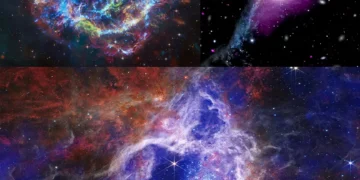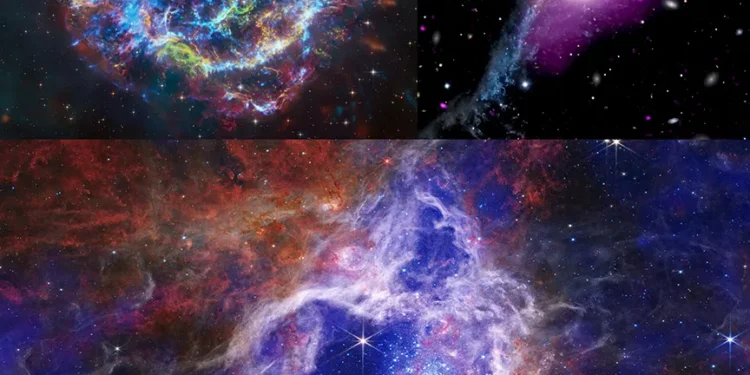Have you ever wondered what the universe might sound like if we could hear it? NASA’s latest sonification project brings this question to life by converting astronomical data into sound.
What is Sonification?
Sonification is a groundbreaking method that translates data into sound, turning the science of space into an audible experience. While most people are familiar with the stunning visuals from telescopes, sonification takes it a step further by converting data—such as light wavelengths, star temperatures, and cosmic distances—into music. This process is not just a gimmick; it is a scientifically robust way to represent data, making it accessible to a broader audience, including those who are visually impaired. NASA’s Universe of Learning program, in collaboration with Chandra’s X-ray Observatory, has been at the forefront of using sonification to bring the cosmos to life through sound.
By assigning different sounds to various types of data, astronomers can convey complex information in a way that is both informative and engaging. For example, X-ray data from Chandra might be mapped to piano notes, while infrared data from the James Webb Space Telescope could correspond to string instruments. This unique combination of science and art makes sonification a powerful tool for education and public engagement.
The Milestone – 25 Years of Chandra X-ray Observatory
Celebrating its 25th anniversary, NASA’s Chandra X-ray Observatory continues to revolutionize our understanding of the universe. Since its launch in 1999, Chandra has provided some of the most detailed X-ray images of the cosmos, revealing phenomena that are invisible in other wavelengths. Its “First Light” image of the supernova remnant Cassiopeia A marked the beginning of a new era in X-ray astronomy, showcasing the capabilities of high-resolution imaging of celestial events.
Chandra’s role in space exploration cannot be overstated. It has contributed to significant discoveries, such as understanding the behavior of black holes, the nature of dark matter, and the lifecycle of stars. The sonifications released to celebrate Chandra’s anniversary are a testament to the observatory’s legacy, offering a new way to experience these cosmic phenomena.
Sonification of Cassiopeia A (Cas A)
Cassiopeia A, a supernova remnant located about 11,000 light-years from Earth, is one of the most studied objects in X-ray astronomy. Chandra’s observations have unveiled intricate details about Cas A, including the distribution of elements like silicon and iron in the supernova debris. The sonification of Cassiopeia A takes data from Chandra, Webb, and Hubble, and transforms it into a symphony of cosmic sounds.
In this sonification, X-ray data from Chandra are mapped to piano sounds, representing the hot gas expelled by the supernova explosion. The infrared data from Webb, which detects dust warmed by this hot gas, are assigned to string and brass instruments. The result is a layered composition that allows listeners to “hear” the structure and dynamics of this celestial remnant. This approach not only makes the data accessible to a wider audience but also provides a deeper understanding of the processes that shaped Cas A.
Sonification of 30 Doradus (Tarantula Nebula)
The Tarantula Nebula, or 30 Doradus, is another cosmic marvel that has been brought to life through sonification. Located in a neighboring galaxy, 30 Doradus is one of the largest and most active regions of star formation. This vibrant stellar nursery is teeming with gas clouds, young stars, and shock waves, all of which have been captured by Chandra and Webb.
The sonification of 30 Doradus combines data from multiple wavelengths to create a rich audio experience. X-ray data from Chandra, which reveals gas heated by shock waves from massive stars, are translated into airy synthesizer sounds. Meanwhile, Webb’s infrared data, which shows cooler gas, are mapped to soft, low musical pitches and wind-like sounds. This combination provides an auditory map of the nebula, allowing listeners to explore the interactions between gas clouds and young stars.
Sonification of NGC 6872
NGC 6872, a massive spiral galaxy with elongated arms stretching across space, is another fascinating subject of NASA’s sonification project. This galaxy, observed in both X-ray and optical light by Chandra and Hubble, is interacting with a smaller neighboring galaxy, creating a cosmic dance that has intrigued astronomers for years.
The sonification of NGC 6872 captures the complexity of this interaction. X-rays from Chandra, which reveal multimillion-degree gas, are represented by wind-like sounds, while Hubble’s optical data are played as a low drone for the galaxy’s core and brighter tones for the spiral arms. This auditory representation provides a unique perspective on galactic interactions, highlighting how gravitational forces can shape and transform entire galaxies over time.
Broader Implications and Future of Sonification in Astronomy
The sonification of astronomical data has broader implications beyond just providing an alternative way to experience space. It opens up new avenues for scientific discovery and education. For visually impaired individuals, sonification offers a way to “see” the universe through sound. It also engages the public, making complex scientific concepts more accessible and inspiring future generations of astronomers and space enthusiasts.
Moreover, the success of NASA’s sonification project demonstrates the potential for future endeavors. As technology advances and more data becomes available from telescopes like Chandra, Webb, and Hubble, the possibilities for sonification are endless. Future projects could include more detailed sonifications of other celestial phenomena, such as black hole mergers, gamma-ray bursts, and even exoplanet atmospheres.
Conclusion
NASA’s sonification project is a groundbreaking initiative that brings the wonders of the universe to life in a way that is both accessible and engaging. By converting complex astronomical data into sound, NASA has created a new dimension of experiencing and understanding the cosmos. From the intricate sounds of Cassiopeia A to the dynamic symphony of 30 Doradus and the cosmic dance of NGC 6872, these sonifications offer a unique glimpse into the universe’s most fascinating phenomena.
As we continue to explore the universe through the lens of advanced telescopes and innovative techniques like sonification, one thing is clear: there is still so much to learn and discover. And now, thanks to these cosmic melodies, we have a new way to listen to the stories the universe has to tell.
Reference
Arcand, K., Russo, M., Santaguida, A., et al. (2024). Sonifying Chandra X-ray Data: A New Path to Astronomical Insight. Retrieved from https://chandra.si.edu/sound/



















